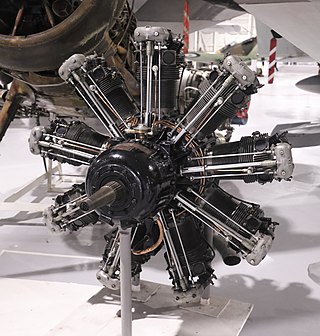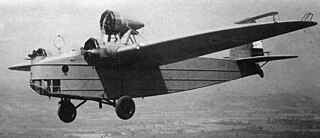| Do R Superwal | |
|---|---|
 | |
| Role | Flying Boat Airliner |
| Manufacturer | Dornier |
| First flight | September 1926 |
| Primary users | Deutsche Luft Hansa SANA |
| Number built | 19 |
The Dornier Do R Superwal was a German flying boat airliner of the 1920s.
| Do R Superwal | |
|---|---|
 | |
| Role | Flying Boat Airliner |
| Manufacturer | Dornier |
| First flight | September 1926 |
| Primary users | Deutsche Luft Hansa SANA |
| Number built | 19 |
The Dornier Do R Superwal was a German flying boat airliner of the 1920s.
The Do R was a larger development of the Do J, with a larger high-mounted strut-braced monoplane wing and longer fuselage. All but the first three built also had four engines, in place of the Do J's two. The Do R could carry 19 passengers in two cabins; 11 in the forward cabin and eight in the rear.
The first R 2 Superwal, (D-1115), made its maiden flight on 30 September 1926. Two 650 hp Rolls-Royce Condor III engines were mounted in tandem in a nacelle above the wing and in line with the hull; one engine drove a tractor propeller and the other drove a pusher propeller. D-1115 was the largest flying boat that could be built in the postwar Dornier factory in Manzell. The Superwal went into service with Severa and later DVS in List, both organisations of the German government, tasked to develop military seaplanes, ignoring restrictions of the Versailles treaty. Two more R 2 Superwals were built in 1927 for Severa (D-1255 and D-1385). D-1255 was periodically operated by Deutsche Luft Hansa and was named Narwal . D-1385 was equipped with 800 hp Packard engines, and remained in service until November 1936.
Between 20 January and 5 February 1927 Dornier Chief Pilot Richard Wagner established twelve world records for seaplanes with a new R4 GasSuperwal. This aircraft and eleven more with Gnome et Rhône Bristol-Jupiter engines (R4 Gas) or 525 hp Siemens-Bristol-Jupiter engines (R4 Sas) were delivered to the Italian airline Società Anonima Navigazione Aerea (SANA) and Luft Hansa during 1928 and ‘29. Apart from their use by Luft Hansa, six Superwals saw regular service with SANA into the early 1930s on a route along the Italian west coast and on to Spain. Three aircraft were lost during their service. The Superwal I-RUDO (equipped with Isotta Fraschini Asso 500 engines) went into service with the Italian Air Ministry in 1934 and became the last Superwal in Italian service. At least one aircraft was assembled in Spain by CASA.

General characteristics
Performance

The Bristol Jupiter is a British nine-cylinder single-row piston radial engine that was built by the Bristol Aeroplane Company. Originally designed late in World War I and known as the Cosmos Jupiter, a lengthy series of upgrades and developments turned it into one of the finest engines of its era.

The Heinkel He 70 Blitz ("lightning") was a German mail plane and fast passenger monoplane aircraft of the 1930s designed by Heinkel Flugzeugwerke, which was later used as a bomber and for aerial reconnaissance. It had a brief commercial career before it was replaced by larger types. The He 70 had set eight world speed records by the beginning of 1933.

The Dornier Do 11 was a German heavy bomber, developed in secret in the early 1930s. It was originally called the Dornier F before being renamed by the Reichsluftfahrtministerium (RLM) in 1933, and was considered a heavy bomber at the time. It came into service in 1932, a continuation of a line of bomber designs from the Dornier Do P in 1930, and the Dornier Do Y in 1931. The line would continue to develop with the Dornier Do 13 and Dornier Do 23.

The Dornier Do J Wal ("whale") is a twin-engine German flying boat of the 1920s designed by Dornier Flugzeugwerke. The Do J was designated the Do 16 by the Reich Air Ministry (RLM) under its aircraft designation system of 1933.

The Junkers F 13 was the world's first all-metal transport aircraft, developed in Germany at the end of World War I. It was an advanced cantilever-wing monoplane, with enclosed accommodation for four passengers, and a two seat open-air cockpit. 322 planes of the type were manufactured, which was exceptionally large number for a commercial airliner of the era, and were operated all over the globe. It accounted for over a third of air traffic in the early 1920s. It was in production for thirteen years and in commercial service for more than thirty. There were many versions including floatplanes for water landing, skis, mailplane, and different engines. Several survived in various states of repair in museums, and a replica of the type was put back in production in the 2010s;taking flight once again nearly a century after it first flew.

The Dornier Do X was the largest, heaviest, and most powerful flying boat in the world when it was produced by the Dornier company of Germany in 1929. First conceived by Claude Dornier in 1924, planning started in late 1925 and after over 240,000 work-hours it was completed in June 1929.

The Dornier Do 18 was a development of the Do 16 flying boat. It was developed for the Luftwaffe, but Luft Hansa received five aircraft and used these for tests between the Azores and the North American continent in 1936 and on their mail route over the South Atlantic from 1937 to 1939.

The Arado Ar 64 was a single-seat biplane fighter designed and produced by the German aircraft manufacturer Arado. It was among the first fighters produced when Germany abandoned the restrictions of the Treaty of Versailles and began rearming.

The Junkers G 24 was a German three-engine, all-metal low-wing monoplane passenger aircraft manufactured by Junkers from 1925. Junkers F 24 was the designation for single-engine versions of the same aircraft.

The Albatros L 73 was a German twin-engined biplane airliner of the 1920s. Of conventional configuration, it featured a streamlined, boat-like fuselage and engine nacelles. All four manufactured aircraft of that type were operated by Deutsche Luft Hansa, one of which crashed near Babekuhl on 28 May 1928.
The Arado V.1 was a prototype airliner, built in Germany in 1927. It was a single-engine, high-wing braced monoplane with tailwheel undercarriage. It made several long-distance flights, including carrying mail to South America, before being exhibited in Berlin in 1929, when it was bought by Deutsche Luft Hansa.

The Dornier Libelle, also designated Do A, was a German open-cockpit, all-metal, parasol wing, monoplane flying boat aircraft, with partly fabric-covered wings. A landplane version, built without sponsons and fitted with a fixed tailwheel undercarriage was produced as the Dornier Spatz.

The Focke-Wulf A 17 Möwe was an airliner built in Germany in the late 1920s. It was a conventional high-wing cantilever monoplane with fixed tailwheel undercarriage. The aircraft provided fully enclosed seating for up to eight passengers and had a separate, fully enclosed flight deck for the two pilots. Most examples flew with Deutsche Luft Hansa, serving until around 1936. In the early 1930s, two A 17s were used for testing the Junkers Jumo 5 diesel engine.

Rohrbach Ro V was a seaplane manufactured by the Rohrbach Metall-Flugzeugbau company in Berlin, Germany. Only one was built, in 1927. It was delivered to Severa GmbH for comparison flights with the Dornier Do J "Superwal" and as a seaplane trainer. It was used for commercial flights in 1928 by the Deutsche Luft Hansa for the Travemünde to Oslo route.

Gressholmen Airport was a water aerodrome situated the island of Gressholmen in Oslo, Norway. It served as the main airport for Oslo from 1927 to 1939, along with Kjeller Airport. The aerodrome consisted of docks, a landing ramp, terminal building and a hangar and used a section of the Oslofjord as its runway. Being located on an island it was necessary to transport passengers by boat to the island. The airport only operated during the summer, typically from May through September.

The Junkers G 31 was an advanced tri-motor airliner produced in small numbers in Germany in the 1920s. Like other Junkers types, it was an all-metal, low-wing cantilever monoplane. In the mid-1920s, the all-metal construction and an aerodynamically 'clean' configuration were remarkable.

The Dornier Do Y was a trimotor German monoplane bomber of the early 1930s designed by Dornier Flugzeugwerke to an order by the Royal Yugoslav Air Force (RYAF). The Yugoslavs originally intended to use war reparations to pay for them, but ultimately had to use their own funds. Only a pair of aircraft were initially ordered to give the Yugoslavs experience with multi-engine bombers and Dornier failed to sell any more Do Y's. Two improved versions were subsequently built on speculation, but failed to find purchasers until the RYAF bought them in 1935.

The Dornier Do K was a German commercial passenger and freight monoplane, designed by Claude Dornier and built by Dornier Flugzeugwerke. Only three prototypes of different designs were built and the type was not a commercial success.

The Dornier Do P was a German four-engined heavy bomber, manufactured by Dornier Flugzeugwerke in the 1930s. It was built as part of the secret rearmament of Germany, in opposition to the Treaty of Versailles.

The Fizir F1V was the basis from which engineer Rudolf Fizir developed a series of single-engined, two-seat, reconnaissance biplanes fitted with different engines. Construction was carried out in the Yugoslav aircraft factories Zmaj and Rogožarski between 1928 and 1932.